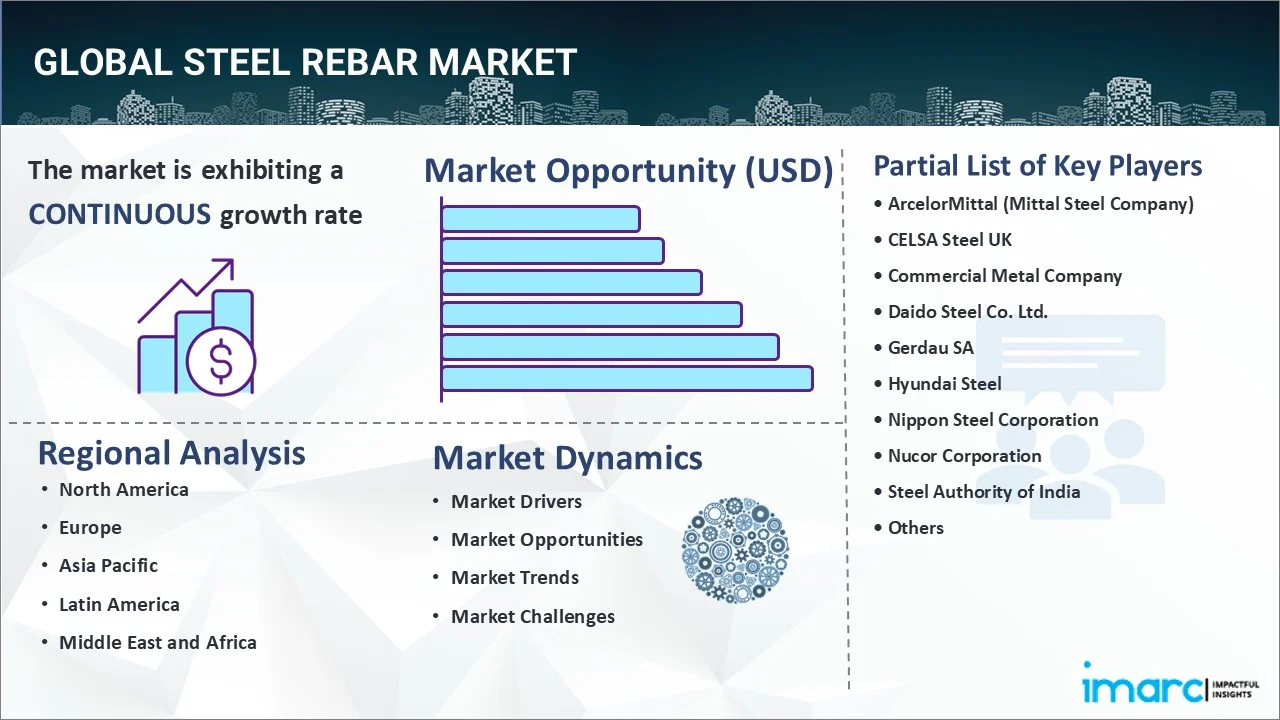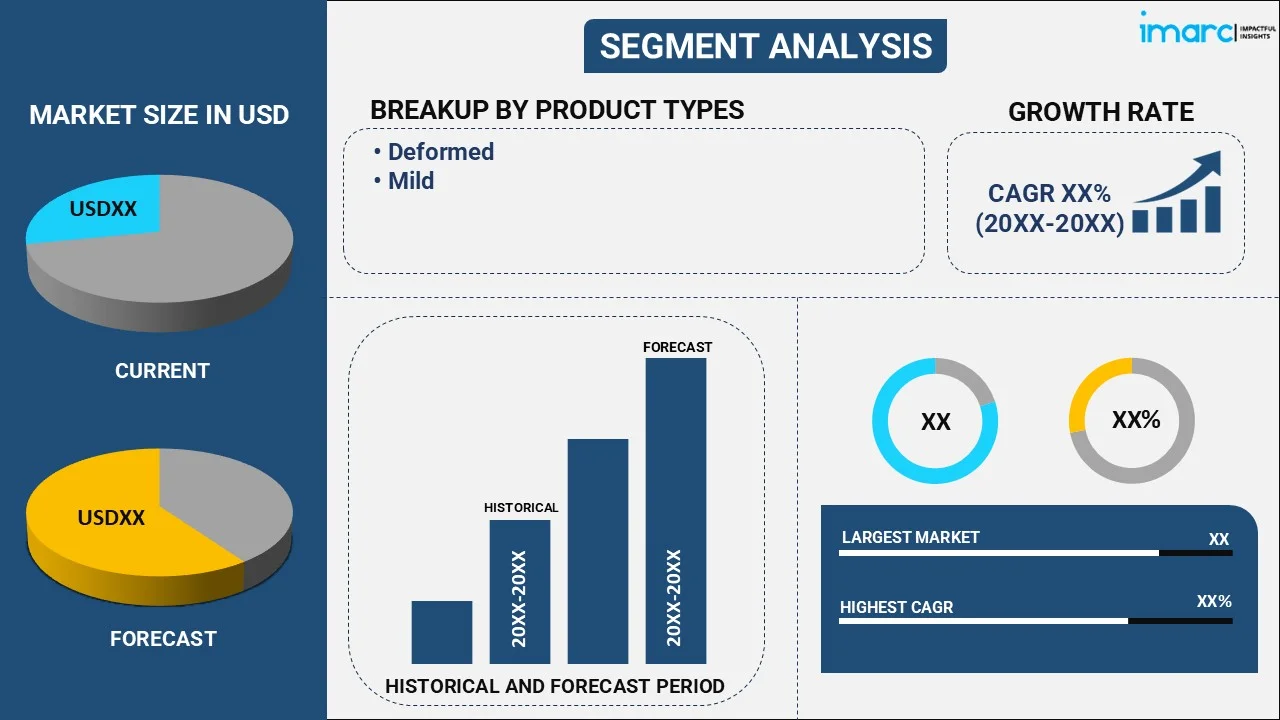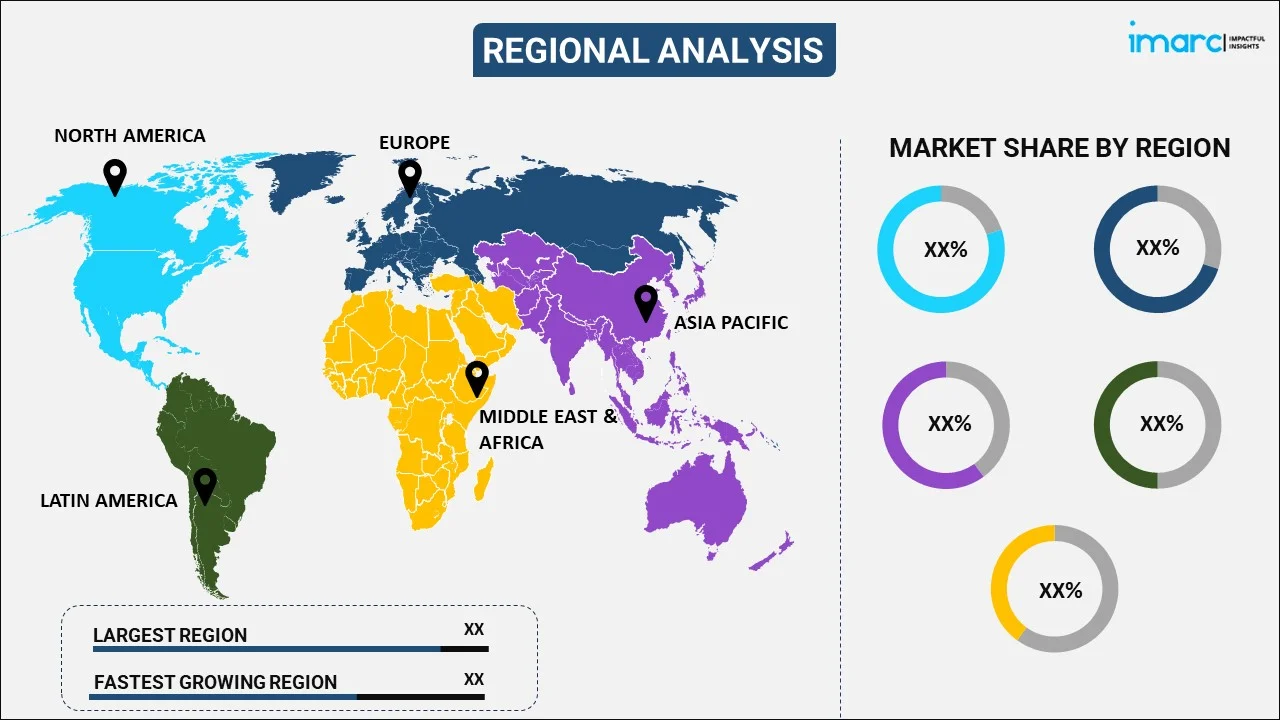
Steel Rebar Market Report by Product Type (Deformed, Mild), Process (Basic Oxygen Steelmaking, Electric Arc Furnace), Finishing Type (Epoxy, Coated, Black), End Use (Residential, Commercial, Industrial), and Region 2025-2033
Steel Rebar Market Size:
The global steel rebar market size reached USD 259.0 Billion in 2024. Looking forward, IMARC Group expects the market to reach USD 411.5 Billion by 2033, exhibiting a growth rate (CAGR) of 5.3% during 2025-2033. The heightened investments in infrastructure development around the world, increasing construction of several residential and commercial buildings, and rising need for durable and cost-effective construction materials capable of withstanding harsh climatic conditions are supporting the market growth.
|
Report Attribute
|
Key Statistics
|
|---|---|
|
Base Year
|
2024
|
|
Forecast Years
|
2025-2033
|
|
Historical Years
|
2019-2024
|
|
Market Size in 2024
|
USD 259.0 Billion |
|
Market Forecast in 2033
|
USD 411.5 Billion |
| Market Growth Rate (2025-2033) | 5.3% |
Steel Rebar Market Analysis:
- Major Market Drivers: The market is experiencing moderate growth, driven by increasing investments in infrastructure development projects around the world and heightened need for cost-effective building materials.
- Key Market Trends: Major trends include the integration of artificial intelligence (AI) and other advanced technologies to streamline and improve steel making process and rising construction of various residential and commercial buildings.
- Geographical Trends: Asia Pacific represents the largest segment owing to rising funding in building durable residential buildings.
- Competitive Landscape: Some of the major market players in the steel rebar industry include ArcelorMittal (Mittal Steel Company), CELSA Steel UK, Commercial Metal Company, Daido Steel Co. Ltd., Gerdau SA, Hyundai Steel, Nippon Steel Corporation, Nucor Corporation, Steel Authority of India, Jiangsu Shagang Group Company Limited, Steel Dynamics Inc., and Tata Steel Limited.
- Challenges and Opportunities: Challenges include fluctuating prices of raw materials, stringent environmental regulations, and rapid pace of innovation. However, the heightened need for cost effective and sustainable construction materials, along with increasing investments in infrastructure development, are expected to overcome these complications and improve steel rebar market dynamics.

Steel Rebar Market Trends:
Urbanization and Infrastructure Development
The World Bank estimates that 7 out of 10 people will live in cities by 2050. Huge investments in the development of infrastructure combined with rapid urbanization, mostly propel the market for steel rebar. With the increasing urbanization, the demand for reliable and sustainable construction materials is rising owing to the building of residential, commercial, and industrial setups. Infrastructure like bridges, highways, and public transportation systems are also a major focus of government spending globally. Rough terrain is characteristic of most active seismic zones, and many projects such as schools, buildings, bridges, and roads require large amounts of steel rebar to reinforce them, maintain their structural integrity and sustain damage. This has been made worse by the rallying cry for smart cities and urban planning, as modern structures often require top-of-the-line materials such as steel rebar. Therefore, urbanization and infrastructure development continue to be the key to the growth of the steel rebar market price.
Growth in the Construction Industry
The market is directly proportional to the upswing in the global construction industry. Rising spending on residential and commercial construction activities is majorly driving the demand for steel rebar as it is used as a tensioning device for reinforced concrete, delivering adequate tensile strength and stability to concrete structures. This is mainly due to the construction boom in emergent countries, which are driven by robust economic growth combined with rapid population increase. The growing trend of sustainability and green buildings is positively influencing the market as steel rebar is recyclable in nature and has limited environmental impact. This trend of increasing construction activity along with the growing requirement for environmentally friendly construction materials will continue to make steel rebar an important material in various construction applications. According to the IMARC Group’s report, the global green building materials market will hit US$ 716.4 Billion in 2032.
Advancements in Manufacturing Technologies
Constant advancements in steel processing methods and technological & innovative developments is offering a favorable market outlook. The commercialization of high-strength, corrosion-resistant rebar products has extended its applicational area and enhanced the performance of steel rebar for use in construction. The advent of contemporary production techniques involving thermo-mechanical treatment and micro-alloying have aided in the production of rebar with improved mechanical properties and extended durability. These technological advances are also driving the development of more streamlined manufacturing processes, improving the cost-effectiveness of production and keeping the cost of steel rebar more competitive in the market. In addition, digital technologies and automation have facilitated steel production, which enhances the uniformity as well as quality control of steel rebar, thereby fostering its demand for construction activities. In 2023, United States Steel Corporation and Google Cloud announced a collaboration to build applications that tap the power and flexibility of Google Cloud's Generative artificial intelligence (gen AI) technology to help drive improved operations in the largest iron ore mine in North America.
Steel Rebar Market Segmentation:
IMARC Group provides an analysis of the key trends in each segment of the market, along with forecasts at the global, regional, and country levels for 2025-2033. Our report has categorized the market based on product type, process, finishing type and end use.
Breakup by Product Type:

- Deformed
- Mild
Deformed accounts for the majority of the market share
The report has provided a detailed breakup and analysis of the market based on the product type. This includes deformed and mild. According to the report, deformed represented the largest segment.
Deformed steel rebar constitutes the most prominent segment as a result of the superior physical characteristics of deformed steel rebar and its extensive uses in construction. Rough or deformed surface rebars provide better anchoring with concrete for bond strength. Correct adhesion is crucial when it comes to structural integrity. It is the increased adhesion that makes deformed rebars the prime choice to reinforce concrete in areas of high stress like foundations, columns, and beams. Their resistance to high tensional strength, without allowing them to slide onto each other, makes them ideal materials for mega-structure projects like bridges, highways, and skyscrapers. Moreover, the modified characteristics of deformed steel rebar with respect to environmental factors, especially corrosion and seismic activity, surge the demand for deformed steel rebar. In 2023, an article by the World Economic Forum noted climate change as one of the major causes of earthquakes. This also results in broader awareness and demand for materials for sustainable construction which can withstand the effects of earthquakes.
Breakup by Process:
- Basic Oxygen Steelmaking
- Electric Arc Furnace
Basic oxygen steelmaking holds the largest share of the industry
A detailed breakup and analysis of the market based on the process have also been provided in the report. This includes basic oxygen steelmaking and electric arc furnace. According to the steel rebar market report, basic oxygen steelmaking accounted for the largest market share.
Basic oxygen steelmaking (BOS) is the largest segment due to its efficiency and ability reduce high quality steel. This process involves blowing oxygen through molten pig iron to reduce the carbon content and transform it into steel. The BOS method is extremely favored in the industry as it significantly shortens production time compared to other methods while also ensuring a consistent quality of the end product produced. The process is capable of producing large quantities of steel rebar, making it ideal for meeting the demands of extensive construction projects. Furthermore, the BOS process is cost effective as it allows for the recycling of scrap steel, thereby reducing raw material costs and environmental impact. Recently ArcerlorMittal Nippon Steel (AM/NS) India planned to establish steel scrap processing centers across the country, while Tata Steel planned to set up electric arc furnace based recycling plants.
Breakup by Finishing Type:
- Epoxy
- Coated
- Black
The report has provided a detailed breakup and analysis of the market based on the finishing type. This includes epoxy, coated, and black.
Epoxy coated rebar is gaining traction due to its superior corrosion resistant properties. The epoxy coating functions like a barrier that protects the steel from environmental factors like moisture and chemicals, which can cause rust and deterioration over time. This makes epoxy-coated rebar particularly suitable for use in harsh environments, such as marine structures, bridges, and highways, where exposure to saltwater or de-icing salts is common. The enhanced durability of epoxy-coated rebar extends the lifespan of structures, lowering maintenance costs and improving safety.
Coated rebar, which includes various types of protective coatings such as galvanized and polymer coating, offers enhanced protection against corrosion and abrasion. Galvanized rebar, for instance, is quoted with a layer of zinc, providing a robust shield against rust. This type of rebar is particularly useful in environments where exposure to corrosive elements is a concern.
Black rebar or uncoated rebar is the most commonly used type due to its cost effectiveness and wide availability. It is often used in applications where the risk of corrosion is low or where the structure is not exposed to harsh environmental conditions.
Breakup by End Use:
- Residential
- Commercial
- Industrial
Residential exhibits a clear dominance in the market
A detailed breakup and analysis of the market based on the end use have also been provided in the report. This includes residential, commercial, and industrial. According to the report, residential accounted for the largest market share.
The residential segment holds the biggest market share, driven by the ongoing demand for housing and residential infrastructure. Organization and population growth are three factors contributing to the expansion of this segment, as they necessitate the development of new residential buildings, apartments, and housing complexes. The use of steel rebar in residential construction is crucial for reinforcing concrete structures, ensuring their durability and safety. Furthermore, the increasing trend of high-rise residential buildings in urban areas requires substantial quantities of steel rebar to provide the necessary structural support.
Breakup by Region:

- North America
- United States
- Canada
- Asia Pacific
- China
- Japan
- India
- South Korea
- Australia
- Indonesia
- Others
- Europe
- Germany
- France
- United Kingdom
- Italy
- Spain
- Russia
- Others
- Latin America
- Brazil
- Mexico
- Others
- Middle East and Africa
Asia Pacific leads the market, accounting for the largest steel rebar market share
The report has also provided a comprehensive analysis of all the major regional markets, which include North America (the United States and Canada); Asia Pacific (China, Japan, India, South Korea, Australia, Indonesia, and others); Europe (Germany, France, the United Kingdom, Italy, Spain, Russia, and others); Latin America (Brazil, Mexico, and others); and the Middle East and Africa. According to the report, Asia Pacific represents the largest regional market for steel rebar.
The Asia-Pacific steel rebar market is driven by a combination of robust urbanization, extensive infrastructure development, and rapid industrialization across the region. Countries such as China, India, and Indonesia are at the forefront of this expansion, with massive investments in transportation networks, residential projects, and commercial buildings. Government initiatives aimed at modernizing infrastructure and providing affordable housing further stimulate the demand for steel rebar. Additionally, the increasing adoption of advanced construction technologies and sustainable building practices is enhancing the quality and efficiency of rebar production and usage. The rise of smart cities and the development of high-speed rail networks and bridges also contribute to the market's expansion. Moreover, the burgeoning population and economic growth in the region create a continuous need for new construction projects, ensuring a steady demand for steel rebar.
Competitive Landscape:
- The market research report has also provided a comprehensive analysis of the competitive landscape in the market. Detailed profiles of all major companies have also been provided. Some of the major market players in the steel rebar industry include ArcelorMittal (Mittal Steel Company), CELSA Steel UK, Commercial Metal Company, Daido Steel Co. Ltd., Gerdau SA, Hyundai Steel, Nippon Steel Corporation, Nucor Corporation, Steel Authority of India, Jiangsu Shagang Group Company Limited, Steel Dynamics Inc., Tata Steel Limited, etc.
(Please note that this is only a partial list of the key players, and the complete list is provided in the report.)
- Leading companies are investing heavily in advanced manufacturing technologies to improve the quality and efficiency of steel rebar production. Innovations such as thermo-mechanical treatment, micro-alloying, and automation are being adopted to produce high-strength, corrosion-resistant rebar with consistent quality. These advancements help reduce production costs and enhance product performance, making the rebar more competitive in the market. To meet the increasing demand from the construction and infrastructure sectors, key players are expanding their production capacities. This includes setting up new manufacturing plants, upgrading existing facilities, and optimizing supply chains. Expanding capacity not only helps in catering to larger orders but also in maintaining a steady supply to various markets, ensuring timely delivery and customer satisfaction. Forming strategic alliances and partnerships is another key strategy. By collaborating with construction firms, technology providers, and research institutions, steel rebar manufacturers can enhance their market reach, innovate new products, and streamline operations. Partnerships also facilitate the sharing of best practices and access to new markets, bolstering the companies' competitive edge. For instance, Commercial Metals Company in 2023 planned to spend up to $ 600 million to fund growth projects and mergers and acquisitions (M&A).
Steel Rebar Market News:
- February 2024: ArcelorMittal Nippon Steel India outlined proactive measures to reduce emissions intensity by 20% in the coming years by adopting actions across the entire value chain of steel production.
- December 2023: Gerdau Long Steel America announced the completion of the commissioning of its new Gerdau Midlothian Steel Processing (GMSP) heart treatment facility.
Steel Rebar Market Report Scope:
| Report Features | Details |
|---|---|
| Base Year of the Analysis | 2024 |
| Historical Period | 2019-2024 |
| Forecast Period | 2025-2033 |
| Units | Billion USD |
| Scope of the Report | Exploration of Historical Trends and Market Outlook, Industry Catalysts and Challenges, Segment-Wise Historical and Future Market Assessment:
|
| Product Types Covered | Deformed, Mild |
| Processes Covered | Basic Oxygen Steelmaking, Electric Arc Furnace |
| Finishing Types Covered | Epoxy, Coated, Black |
| End Uses Covered | Residential, Commercial, Industrial |
| Regions Covered | Asia Pacific, Europe, North America, Latin America, Middle East and Africa |
| Countries Covered | United States, Canada, Germany, France, United Kingdom, Italy, Spain, Russia, China, Japan, India, South Korea, Australia, Indonesia, Brazil, Mexico |
| Companies Covered | ArcelorMittal (Mittal Steel Company), CELSA Steel UK, Commercial Metal Company, Daido Steel Co. Ltd., Gerdau SA, Hyundai Steel, Nippon Steel Corporation, Nucor Corporation, Steel Authority of India, Jiangsu Shagang Group Company Limited, Steel Dynamics Inc., Tata Steel Limited, etc. |
| Customization Scope | 10% Free Customization |
| Post-Sale Analyst Support | 10-12 Weeks |
| Delivery Format | PDF and Excel through Email (We can also provide the editable version of the report in PPT/Word format on special request) |
Key Benefits for Stakeholders:
- IMARC’s industry report offers a comprehensive quantitative analysis of various market segments, historical and current market trends, market forecasts, and dynamics of the steel rebar market from 2019-2033.
- The research report provides the latest information on the market drivers, challenges, and opportunities in the global steel rebar market.
- The study maps the leading, as well as the fastest-growing, regional markets. It further enables stakeholders to identify the key country-level markets within each region.
- Porter's five forces analysis assists stakeholders in assessing the impact of new entrants, competitive rivalry, supplier power, buyer power, and the threat of substitution. It helps stakeholders to analyze the level of competition within the steel rebar industry and its attractiveness.
- The competitive landscape allows stakeholders to understand their competitive environment and provides insight into the current positions of key players in the market.
Key Questions Answered in This Report
The steel rebar market was valued at USD 259.0 Billion in 2024.
The steel rebar market is projected to exhibit a CAGR of 5.3% during 2025-2033, reaching a value of USD 411.5 Billion by 2033.
The steel rebar market is propelled by escalating global infrastructure and construction activities, including residential, commercial, and industrial projects. Urbanization, government-backed development initiatives, and robust demand for durable, reinforced concrete structures drive growth. Additionally, advancements in production technology and sustainable steelmaking practices enhance quality and environmental compliance.
Asia Pacific currently dominates the steel rebar market, fueled by extensive infrastructure developments, increasing urbanization, and high demand from the residential and commercial construction industries. Government investments in transport networks, smart cities, and industrial expansion in countries like China, India, and Indonesia continue to boost the need for reinforced concrete structures.
Some of the major players in the steel rebar market include ArcelorMittal (Mittal Steel Company), CELSA Steel UK, Commercial Metal Company, Daido Steel Co. Ltd., Gerdau SA, Hyundai Steel, Nippon Steel Corporation, Nucor Corporation, Steel Authority of India, Jiangsu Shagang Group Company Limited, Steel Dynamics Inc., Tata Steel Limited, etc.
Need more help?
- Speak to our experienced analysts for insights on the current market scenarios.
- Include additional segments and countries to customize the report as per your requirement.
- Gain an unparalleled competitive advantage in your domain by understanding how to utilize the report and positively impacting your operations and revenue.
- For further assistance, please connect with our analysts.
 Request Customization
Request Customization
 Speak to an Analyst
Speak to an Analyst
 Request Brochure
Request Brochure
 Inquire Before Buying
Inquire Before Buying




.webp)




.webp)












